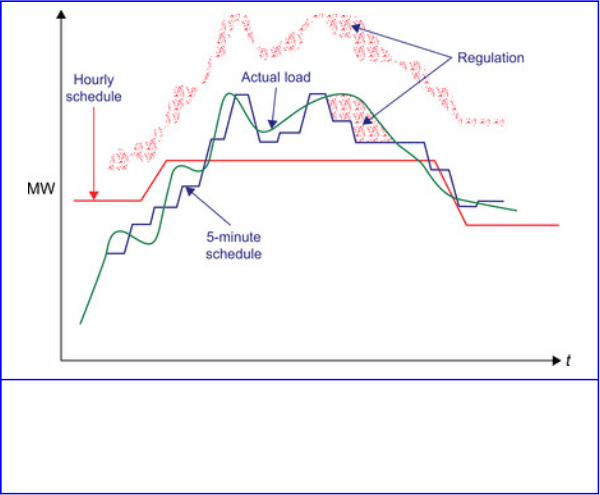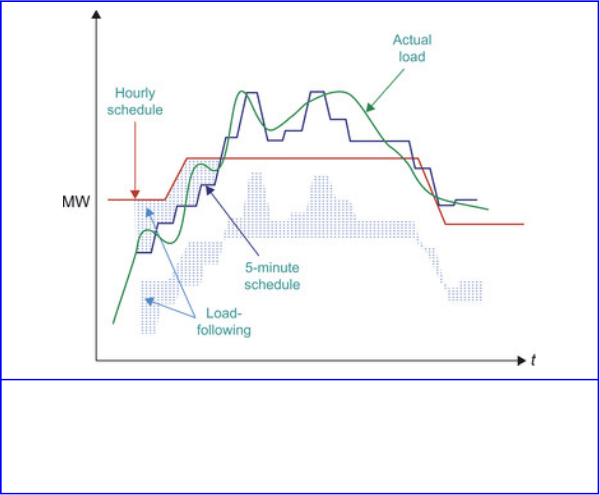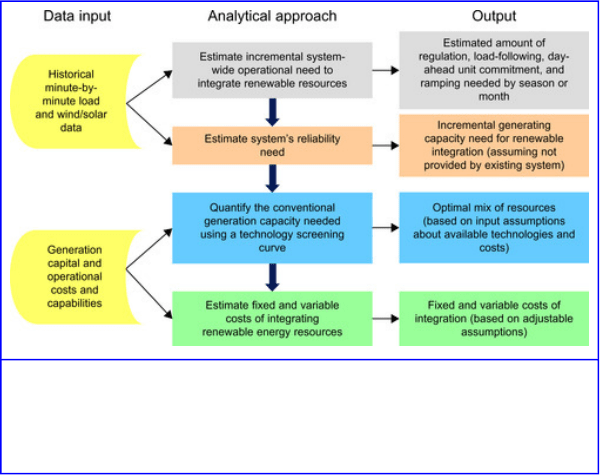Sioshansi F.P. Smart Grid: Integrating Renewable, Distributed & Efficient Energy
Подождите немного. Документ загружается.

as a Flexible Resource – System Programs and Experience”
point to some additional system challenges in accommodating
large penetration levels of renewable generation; “Structuring
Load Control Products for Intermittent Resources” reviews
recent experience in deploying load as a flexible operation
reserve; and “Conclusion: Benefits of Substituting Load for
Generation” discusses the use of optimal inventory control to
design direct load control programs for providing ancillary
services such as regulation and load-following, as well as the
potential benefits from such an approach in integrating
intermittent resources.
Overview of System Operation Flexibility Issues
The existing power grid system has historically been designed
to serve the continuously fluctuating levels of load from one
instance to the next. The grid, however, was not designed to
simultaneously serve both fluctuating loads and relatively
unpredictable and highly variable generation such as wind
and solar generation. Although conventional load also
exhibits pronounced variability, modern forecasting
techniques have been quite successful in using real-time and
historical electricity usage and weather data to predict
conventional electricity demand. This significant level of load
predictability has given system operators the ability to update
and develop monthly, weekly, and day-ahead resources
schedules and, thus, serve load with the optimal size and type
of resources through a daily optimized unit-commitment
process.
In a traditional system, where virtually all generation
resources are controllable and dispatchable, with the
exception of some hydro generation, and the majority of
electricity demand is served by “baseload” generation such as
501
nuclear and coal, the variations in load are met by generation
that can rapidly respond to instructions to adjust their output
to the oscillating portions of electricity demand above the
“baseload” levels. Meeting the constant variations in
electricity demand is more complex than this and actually
requires several levels of generation scheduling and
generation unit types.
First, on the highest resolution timescales such as
second-to-second and minute-to-minute, certain generators
are interconnected to the grid in a way that allows them to
automatically respond to the varying demand levels. Those
generators provide what are known as “frequency control”
and “regulation” services. “Primary frequency control
involves the autonomous, automatic, and rapid action, that is,
within seconds, of a generator to change its output to
compensate for large changes in frequency. Primary
frequency control actions are especially important during the
period following the sudden loss of generation, because the
actions required to prevent the interruption of electric service
to customers must be initiated immediately (i.e., within
seconds).”
16
16
Eto, Joseph H. et al., Use of Frequency Response Metrics to Assess the
Planning and Operating Requirements for Reliable Integration of
Variable Renewable Generation, Lawrence Berkeley National
Laboratory, LBNL-4121 at p. 9. (http://certs.lbl.gov/pdf/lbnl-4142e.pdf).
In addition to primary frequency control, the grid operator
must have the capability to provide secondary frequency
control. “Secondary frequency control involves slower,
centrally (i.e., externally) directed actions that affect
frequency more slowly than primary control (i.e., in tens of
502
seconds to minutes). Secondary frequency control actions can
be initiated automatically or in response to manual dispatch
commands. Automatic generation control (AGC) is an
automatic form of secondary frequency control that is used
continuously to compensate for small deviations in system
frequency around the scheduled value.”
17
Secondary
frequency control actions can be initiated automatically or in
response to manual dispatch commands.
18
17
Ibid. at p. 9.
18
Ibid. at p. 9.
While AGC is usually referred to as regulation service, its
definition in the sub-hourly time domain varies among control
areas. Some studies of renewable integration have modeled
regulation service on the 10-minute time interval due to
high-resolution wind data limitations.
19
As Figure 10.2
shows, on the other hand, the California Independent System
Operator (CAISO) considers regulation to be secondary
frequency control that opposes deviations within the 5-minute
time scale.
20
19
NREL [4].
20
Further discussion is provided in Chapter 6 by Sanders et al.
503

Figure 10.2
Regulation service in the CAISO.
Source: CAISO Integration of Renewable Resources Report, Fig. 5–19
21
Load-following is another type of ancillary service that has
not yet been formally defined in most energy markets.
Load-following refers to the relatively fast and dynamic
adjustment of generation to meet sub-hourly blocks of
demand (i.e., 10 or 15 minutes). Load-following provides a
similar function to regulation but its time scale is often longer
since the time it encompasses allows for larger and steeper
changes in real-time demand. For example, as Figure 10.3
illustrates, CAISO considers load-following to be the service
that follows the deviations between the five-minute and
hourly block schedules.
504

Figure 10.3
Load-following service in the CAISO.
Source: CAISO Integration of Renewable Resources Report, Fig. 5–15
22
As discussed above, the reliable moment-to-moment
operation of the power grid requires the continuous dispatch
of energy blocks to meet the up and down variability of
demand across several time frames—from instantaneous to
sub-hourly and hourly. In addition, once large levels of
variable and unpredictable solar and wind generation are
added to the grid, even more resources will have to be
devoted to serving the increased variability of net load—that
is, load net of renewable generation. In simple terms, this
need for constant redispatch and readjustment of flexible
generation levels is amplified and complicated significantly
by increasing levels of renewable real-time generation on the
grid. The estimation of future needs for regulation and
load-following services, as well as the characteristics of the
505
generation units that would provide them, has been the main
focus of renewable integration studies.
21
http://www.caiso.com/1ca5/1ca5a7a026270.pdf.
22
Ibid. A similar diagram appears in Chapter 6.
Collectively, the dispatch of generation to compensate for the
constant fluctuations in net load needed to maintain system
equilibrium and reliability can be referred to as “balancing
services.” Depending on the specific magnitude and
characteristics of the future balancing service needs, they can
be provided by already existing generation resources and by a
range of properly designed demand-side products (that is,
contracts with demand-side resources designed to address the
relevant balancing resource needs). The rate at which those
flexible generation units’ output can be varied becomes the
dominant and most essential technical feature because of
wind-generating variability and the steep up and down ramps
needed to regulate and follow load net of wind (“net load”). It
is essential, therefore, that future resource planning and
system design are founded on a critical analysis of the optimal
generation technology mix as renewable wind and solar
generation becomes significant and even potentially dominant
resources on the U.S. power grid.
Deregulated markets and large RTOs already largely provide
a centralized medium for procuring regulation via the
day-ahead market structure. Load-following, on the other
hand, is generally not an explicitly defined market product
and is provided by a range of spinning units. These resources
are dispatched to provide spinning reserves of various
time-span definitions (10-minute, 30-minute spinning
506
reserves, etc.). Traditionally, regulation and load-following
have been provided by conventional generation units, which
meet the technical requirements associated with those
services—ramp rates, ability to follow rapid instructions, and
so on. The majority of renewable integration studies,
however, have identified that a large penetration of wind
generation on the grid will inevitably bring a significant
increase in regulation and, especially, load-following needs
both in terms of capacity, but also ramping capability and
frequency of dispatch. This has prompted the focused interest
in deploying battery and other storage technologies as
highlighted in the recent proposal issued by the FERC with
regards to frequency regulation.
23
23
Frequency Regulation Compensation in the Organized Wholesale Power
Markets, Notice of Proposed Rulemaking, 18 CFR 35 (Feb. 17, 2011),
FERC Stats. & Regs. 61,124 (2011) (NOPR).
Wind Integration Studies and Ancillary Service
Requirements
System owners and operators undertake wind, and in some
cases solar, integration studies to (1) determine the capability
of their systems to integrate large penetrations of variable
renewable energy, (2) estimate the growth in flexible services
required for a reliable system, and (3) estimate the increased
system costs of integrating variable renewable energy
sources.
Wind integration studies are complex system studies that
typically involve challenging modeling tasks such as
developing a highly resolved time series of very large
penetrations of wind power (>15%) or the commitment and
dispatch of a large electricity market. Most integration studies
507
use proprietary methods and models to estimate the growth in
ancillary services required to integrate future wind plant
additions. The proprietary nature of these studies protects
against the disclosure of sensitive or confidential market
information, but it also precludes critical analyses of
individual model components and hinders identifying best
practices. The Brattle Group and Pacific Gas and Electric
collaborated to create an open source Renewable Integration
Model (RIM) to enhance the discussion of identifying the
appropriate methods and assumptions to use for integration
studies.
24
24
For more information, please see Chang et al. Renewable Integration
Model and Analysis. IEEE Transmission and Distribution Conference
and Exposition, 2010.
Figure 10.4 outlines the important inputs, components, and
outputs of the RIM. Important inputs include highly
time-resolved historical wind and solar datasets that are used
to characterize a region's current wind and solar power
variability. This characterization forms a basis from which the
variability of larger penetrations of wind power can be
estimated. Estimating larger penetrations of wind power
involves key assumptions about the degree that wind power
balances itself through the smoothing effect of diversifying
the geographic locations of installed wind plants. The same is
true for solar power. Additionally, the other primary set of
inputs is a characterization of the current generation portfolio
of the system of interest as well as associated capital costs
and operational costs.
508

Figure 10.4
Renewable integration model (RIM) structure and output.
Source: Chang et al. [5]
From these inputs, RIM estimates four key components of a
system: (1) the incremental system-wide operational needs of
a system in order to integrate the energy generated from
renewable resources; (2) the incremental system-wide
reliability needs of a system to maintain a stable system with
larger penetrations of variable renewable energy; (3) the
required generator portfolio to meet the needs identified in 1
and 2; and finally, (3) the fixed and variable costs incurred
integrating the renewable energy resources.
Additional System Challenges
As already noted, here are several important challenges facing
balancing systems that are integrating renewable generation.
First, the uncertainty and variability of renewable wind and
solar generation require that system operators procure
increasing amounts of balancing services. Furthermore, the
509
types of generation technologies expected to provide those
growing amounts of balancing services will have to be
characterized by rapid up- and down-ramping capabilities, as
well as minimally short start-up and cool-down times. It is
still an open question whether these new operating
requirements can be entirely met by existing generation
resources. Moreover, cycling and peaking units that would be
providing such services might potentially be faced with
difficulties in realizing sufficient profits, given the
unpredictable patterns of dispatch calls. It is essential that a
range of future empirical studies and analyses focus on
resolving those issues—the resulting solutions will inevitably
be driven by the specific weather, load, and economic
conditions across various control areas and system operators.
Second, as wind and solar penetration increases significantly,
it is likely that wind and solar generation resources will
displace some of the marginal peaking and cycling fossil-fuel
units. As a result, wind and solar generation could also force
some traditional baseload plants to operate in a way that
resembles cycling units. Most baseload plants, however, are
not designed to operate in that way. Forcing them to do so
will very likely reduce their capacity factors and revenues and
increase their heat rates—all of which is, of course,
significantly disadvantageous to baseload generators. In
addition, the increased wear and tear due to more frequent
cycling of units, which are not traditionally designed to cycle,
will result in higher operation and maintenance costs, further
reducing their profitability. The combined effect of these first
two situations is illustrated in Figure 10.5.
25
25
Source: ERCOT Energy Seminar 2009, Chairman Barry T. Smitherman,
Public Utility Commission of Texas, November 12, 2009.
510
